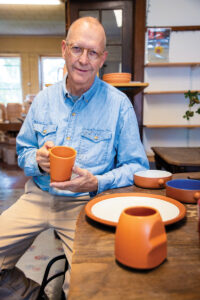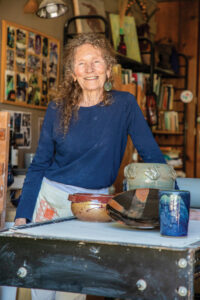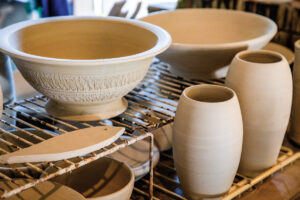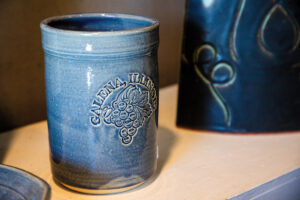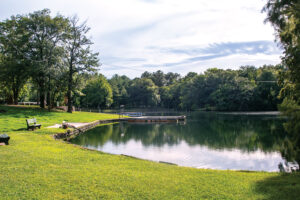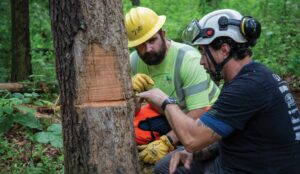There’s no way to create pottery without getting your hands dirty. For more than 20 years, potters around the tri-point border of Illinois, Iowa and Wisconsin have banded together through a group called Twenty Dirty Hands. Three of these potters, who are all consumer-members of Jo-Carroll Energy, are among the original founders of the group.
Eshelman Pottery
Paul Eshelman does pottery a little differently. He doesn’t use a pottery wheel, nor does he form his pieces with his hands. “My process is unusual in the world of clay,” he says. He creates molds out of plaster and pours in liquid clay — that he mixes himself from mud sourced from the Midwest — to make his carefully crafted designs.
“My process is more industrial but scaled down to a small studio,” Eshelman explains.
Growing up in Ames, Iowa, he wanted to get away. After two years at the University of Puget Sound in Washington, he finished his degree at Trinity Western University in British Columbia, where he met his future wife and business partner Laurel. He went on to earn a master’s degree in ceramics at the Rhode Island School of Design.
“In academics, you don’t get business skills. I graduated in ’81, and we didn’t get started here until ’88. It was a process to learn how to sell the work. My technique changed through producing the work, marketing and learning from my mistakes. We were both in it and dedicated to it.”
Now married for 46 years, the Eshelmans moved to Elizabeth in the 1980s, opened the business in 1988 and moved to the current shop and studio, a former car dealership and later a print shop for the local newspaper, in 1990. They haven’t looked back. Paul does the clay work while Laurel focuses on the business side.
Eshelman creates elegant dinnerware pieces with inspiration drawn from Japanese and Chinese ceramics, mid-century pottery, architecture, and industrial pieces like metal fittings, ductwork and corrugated metal.
“[My inspiration] feeds from a number of directions. My work is clean and finished very precisely,” Eshelman explains. “I love doing careful craftsmanship. I take my time to do a good job and finish things the way I think they should be finished and finished well.”
Eshelman has his own signature style. Each piece has a contrast in color with glazed areas and unglazed, unadorned sections, which highlights the color of the clay.
Over the years, the Eshelmans have traveled the U.S. going to shows and exhibitions.
“Pre-pandemic, we did a dozen to 15 shows throughout the year,” Eshelman explains. “You pack up everything you’ve made, [drive] to an art show, unpack, set up the booth, and you’re there for one to three days.”
Eshelman estimates that he crafts thousands of pieces every year. “A lot of my work is cups,” he says, adding that even if customers already have a full set of dinnerware, they will still buy a coffee mug because they are small and affordable.
“I love that I can do what I enjoy doing,” Eshelman says. “I’m doing something I believe in and bringing joy to people’s lives.”
The Pottery
Steph O’Shaughnessy’s first foray into clay was in the late ’60s while on assignment for the local newspaper, the Galena Gazette. “I had never made pottery before, and I didn’t know anything about it. I started reading about it and studying it, and I was just amazed,” she says.
While researching about pottery that flourished in the Upper Mississippi Valley in the 1800s, she discovered that the materials used were sourced from the ground locally. She got in touch with an 80-year-old man who took her digging for clay along the banks of the Mississippi River.
“He starts digging and digging, and I don’t know what we’re looking for. But he’s digging this hole, and he finally unearthed this level of clay. He dug it up, filled a few buckets and I took it home.”
Although her husband had no experience with pottery either, he built her a pottery wheel out of an old door and a wooden chair. “Little by little, I started working with the clay. I was enchanted. I was quickly hooked on this magic material,” O’Shaughnessy says.
She admits her first attempts were not successful, but eventually, she made a few toothpick holders and shot glasses. A friend who was attending the Art Institute of Chicago as a pottery student saw the wheel and said he couldn’t believe she made such beautiful pieces on “that thing.” He eventually gave her a wheel that the school was throwing out, along with a pottery lesson.
O’Shaughnessy went on to earn a scholarship to Anderson Ranch Arts Center in Colorado, and there learned how to work with all kinds of clay and kilns. She has worked with clay ever since.
She describes her pottery as functional. “My work tends to be simple, with occasional little exuberant scribbles on them. I do some sculptural objects, but along the way, it’s been important to pay the rent and get another bag of clay.” Because of this, she has done a lot of commission work over the years.
“Sometimes when I sit down at the wheel, I have a goal … something specific I want to make. Oftentimes I succeed, but sometimes the clay has a different idea. In that case, I have the choice of listening to the clay. I have to let go of that desire to stay on task and have fun.”
Today, O’Shaughnessy keeps busy working in her garage-turned-studio named The Pottery, where she also sells her work. It is open by chance or appointment. She also teaches pottery classes locally to people of all ages. Although she sources her clay out of Wisconsin, this past summer she got her hands back in Galena-area mud during her wild clay program, a children’s course featuring native clay.
“I think the more you teach, the more you learn,” she says. “When a student starts out thinking they’re not going to be good or becomes impatient, my desire is to encourage them. I want them to enjoy their first wonderful, wonky little pots they make.”
She recommends that everyone gets their hands dirty. “Once you get comfortable with the clay, it can be meditative in the quiet with your spinning wheel. [When you] sit at that wheel and start working with the clay, it’s just blissful. It takes you to a different place.”
O’Shaughnessy never expected to become a potter. She planned a career in writing. “To find a passion that you weren’t seeking, and then to get nourishment from unexpected places throughout your life is just amazing. I’m so fortunate. I’m so blessed.”
Galena Clay Works
In the summertime, Kent Henderson’s pottery studio gets stifling hot as the sun beats down on the tin roof. What used to be an old carriage house in the 1800s is now home to Galena Clay Works. Just a short drive past Galena’s Historic Main Street, the pottery shop is hard to miss with the American flag painted on the storefront. It stays open until the building literally freezes shut in the winter.
Henderson, who says he creates artifacts for the future, didn’t intend to have a career in ceramics. Attending the University of Northern Iowa, he studied humanities, anthropology and art, and jokes that he majored in “unemployment.” His life in pottery began in college as “a good way to not party too much,” he says. “A few [classmates] flunked out right away. You just have to manage your social settings.”
That’s when he started taking ceramics. Instead of going out, he’d stay late in the pottery studio catching up on homework and perfecting his craft. Upon graduating in 1984, a friend suggested they move somewhere and be potters. “It sounded like a good plan to me,” Henderson laughs. The two then moved to Galena and rented a space for their studio.
Much like his studio today, the rented space got far too cold in the winter to work. Needing income during the freezing months, they became ski instructors at nearby Chestnut Mountain Resort. In 1991, Henderson was able to open his own studio at the current location, and he retired from being a ski instructor last year after 38 years.
Henderson describes his work as funky to functional. While much of his work is utilitarian — plates, cups and bowls that are both works of art and can be used daily — he also enjoys creating unique sculptures.
“I like the fact that people can use my stuff all the time and [it] be part of their daily lives,” he says. “It’s inspirational that people are using them.”
At the same time, he also has many customers who come for the funky pieces. He calls his ceramic sculptures “pencil sketches.” He forms shapes with his hands and etches details and facial expressions with a pencil. His ghost figures are popular among customers, and he always has a bucket full of them in his store.
“I like messing around with clay,” Henderson says. “It’s pretty to unload the kiln. You kind of know what you’re going to get, but there are times you’re surprised with how great something turned out, or think, ‘Wow, that didn’t turn out like I thought it was going to.’ But I think that’s the nature of ceramics.”
Galena Clay Works is open 9 a.m.-9 p.m. every day until Old Man Winter shuts down the operation. The shop is oftentimes unmanned and runs on the “honesty policy.” Because of this, he’s not always sure if visitors are new or have been customers for 20 years. Regardless, Henderson will greet customers with a friendly, “Welcome or welcome back.”
Twenty Dirty Hands
While there are differing opinions on how the group’s name came to be, there are not always 20 hands in Twenty Dirty Hands, but they are typically covered in clay. The number of members in the group has ebbed and flowed throughout the years. Currently, there are 12 members, as well as members on sabbatical and guest artists.
“We all lived around here, so we all knew about each other,” O’Shaughnessy says about the formation of the group. “We’d get together and talk about clay. It was just a nice, bonding friendship. I think sometimes when there are people in the same art form, they feel competitive. We’ve never been competitive. Everybody’s there for everybody else.”
Eshelman agrees. “We don’t feel like competitors, really. Our work is diverse. It is collaborative more than competitive.”
The three say being part of this group has been a gift. “They’re the people we can go to who can answer questions. We’ll let each other know if there’s a good show they might want to apply for. It’s friendship,” O’Shaughnessy says.
In the spirit of collaboration, the group hosts a pottery tour each fall inviting everyone to visit each participating location, enjoy a variety of works with clay by member and guest potters, meet the artists and watch demonstrations.
“Everybody’s got their own vision and their own uniqueness. So that’s a bonus. Every stop has something different,” Henderson says.
For example, at Henderson’s location, visitors can expect Raku firing demonstrations. While a normal kiln firing process takes a of couple days from firing up to cooling down, Raku is a rapid process that takes about an hour.
He explains that the Raku kiln has a short firing time, going from room temperature to 1,800 degrees Fahrenheit. The pots will then be removed from the kiln while still hot and placed into a bucket filled with sawdust, which immediately combusts. After that, it goes into water to clean it off. Then the pots are done and ready for sale.
The tour is self-guided and will be held Oct. 13-15 this year. Attendees are welcome to visit as many or as few of the seven locations as they want during the three-day event.
“I just feel like it’s a magical experience going to all the different locations,” O’Shaughnessy says. “The fall has beautiful weather, and the trees are changing color. The drive out here is beautiful.”
1. ESHELMAN POTTERY
238 N. Main St., Elizabeth, IL
Featuring Paul Eshelman and guests
2. GALENA CLAY WORKS
704 Dewey Ave., Galena, IL
Featuring Kent Henderson
3. THE POTTERY
202 S. West St., Galena, IL
Featuring Steph O’Shaughnessy, Scott Steder and guests
4. JOHN RICHARD
3573 Highway 11, Hazel Green, WI
Featuring John Richard and guests
5. KEN BICHELL
595 W. 11th St., Dubuque, IA
Featuring Ken Bichell and guests
6. CRICKET HILL POTTERY
2910 Brick Mason Lane, Asbury, IA
Featuring Liz Robertson, Rich Robertson and Ron Hahlen
7. MISSISSIPPI MUD STUDIOS
403 Pershing Road, Maquoketa, IA
Featuring Gary Carstens, Tab Link, Jenni Brant and guests
Go to twentydirtyhands.com for more information and a tour map.


